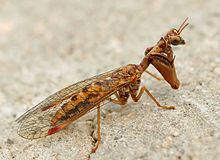- Mantispidae
-
Mantidflies
Temporal range: Early Jurassic – Recent
180–0 Ma
Mantispa styriaca Scientific classification Kingdom: Animalia Phylum: Arthropoda Class: Insecta Order: Neuroptera Suborder: Hemerobiiformia Superfamily: Mantispoidea Family: Mantispidae Subfamilies - Calomantispinae
- Drepanicinae
- Mantispinae
- Symphrasinae
and see text
Synonyms Liassochrysidae
Mantispidae is a family of small to moderate-sized net-winged insects, known as mantidflies, mantispids, mantid lacewings or mantis-flies. There are many genera with around 400 species worldwide,[1] especially in the tropics and subtropics. Only 5 species of Mantispa occur in Europe.[2]
Contents
Description and ecology
About 5–47 millimetres (0.2–1.9 in) long and with a wingspan of 5–30 mm (0.2–1.2 in), some mantidflies (e.,g. Climaciella brunnea) are wasp mimics, but most are brownish with green, yellow and sometimes red hues. They get their name from their mantis-like appearance, as their spiny "raptorial" front legs are modified to catch small insect prey and are very similar to the front legs of mantids. The adults are predatory insects that are often nocturnal, and are sometimes attracted by porch lights or blacklights. They are usually green, brown, yellow, and sometimes pink, and have four membranous wings which may sometimes be patterned (especially in wasp mimicking species) but are usually clear. Adult mantidflies are predators of suitably sized insects, which they catch as mantids do. Mantidflies are active hunters, but as with other Neuroptera, they are cumbersome fliers.
Symphrasinae larvae are sedentary parasitoids on bee, wasp or scarab beetle larvae. Larvae of the Calomantispinae are predators of small arthropods, and in at least one species they are mobile. Mantispinae have the most specialized larval development among all mantidflies studied to date (the life history of the Drepanicinae remains unknown): their campodeiform larvae seek out female spiders or their egg sacs which they then enter; the scarabaeiform larvae then feed on the spider eggs, draining egg contents through a piercing/sucking tube formed by modified mandibles and maxillae, pupating in the egg sac.[1]
First-instar mantispids use two strategies to locate spider eggs: larvae may burrow directly through the silk of egg sacs they find, or they may board and be carried by female spiders prior to sac production (phoresy), entering the sac as it is being constructed. Mantispids that board spiders usually adopt positions on or near the base of the abdomen; some species may enter the spider's book lungs. Larvae maintain themselves aboard spiders by feeding on spider hemolymph. Transfers of larvae from spider to spider are possible during spider mating or cannibalism. All of the major groups of hunting spiders are attacked by spider-boarding mantispids; the egg sacs of web-building species are also entered by egg-sac penetrators.[3]
Systematics
They belong to the order Neuroptera, which includes the lacewings and owlflies as well. The mantidflies are apparently most closely related to the Dilaridae (pleasing lacewings) and the thorny (Rhachiberothidae) and beaded lacewings (Berothidae) These and the prehistoric Mesithonidae - probably a paraphyletic assemblage rather than a natural group - form the superfamily Mantispoidea.[4]
Many mantidflies are placed in one of the four subfamilies, of which the Symphrasinae are probably the most distinct and the Mantispinae are the most advanced. But a considerable number of taxa cannot be easily accommodated in this layout, and are therefore better treated as incertae sedis at present. Some fossil taxa may be of an altogether quite basal position, for example the Jurassic Liassochrysa (about 180 million years old) and Promantispa (about 155 million years old). The Early Jurassic Prohemerobius dilaroides (the type species of the "Prohemerobiidae" assemblage) as well as the Late Permian Permantispa emelyanovi (of the just as likely paraphyletic "Permithonidae") might also be very basal mantidflies.[5]
Most living genera from which fossil species are also known go back to the Miocene; the Oligocene "Climaciella" henrotayi probably does not belong in the living genus. The distinct Mesomantispa is often placed in a monotypic subfamily Mesomantispinae, but given its uncertain position due to no clearly related mantidflies having been found yet in the fossil record, this may well be premature. Basal and incertae sedis mantidfly genera are:[6]
- Dicromantispa - Mantispinae?
- Entanoneura
- Feroseta
- Liassochrysa (fossil)
- Mesomantispa (fossil)
- Nolima
- Plega
- Promantispa Panfilov, 1980 (fossil)
- Vectispa Lambkin, 1986 (fossil) - Mantispinae? Formerly Promantispa Jarzembowski, 1980 (non Panfilov, 1980: preoccupied)[7]
- Zeugomantispa
Paraberotha, Retinoberotha and Whalfera were formerly placed here, but have since been recognized as Rhachiberothidae. Mantispidiptera are diminutive insects, apparently neuropterans of some sort, perhaps Hemerobiiformia; their exact affiliation cannot at present be determined because of their odd apomorphies, though they are unlikely to have been mantidflies.[7]
Footnotes
References
- Aspöck, Ulrike & Aspöck, Horst (2010): Fauna Europaea – Mantispidae. Version of 2010-DEC-23. Retrieved 2011-JAN-03.
- Engel, Michael S. & Grimaldi, David A. (2007): The neuropterid fauna of Dominican and Mexican amber (Neuropterida, Megaloptera, Neuroptera). American Museum Novitates 3587: 1-58. PDF fulltext
- Haaramo, Mikko (2008): Mikko's Phylogeny Archive: Neuroptera. Version of 2008-MAR-11. Retrieved 2008-APR-27.
- Redborg, K. E. (1998): Biology of the Mantispidae. Annual Review of Entomology 43: 175-194. doi:10.1146/annurev.ento.43.1.175 (HTML abstract)
- Wedmann, Sonja & Makarkin, Vladimir N. (2007): A new genus of Mantispidae (Insecta: Neuroptera) from the Eocene of Germany, with a review of the fossil record and palaeobiogeography of the family. Zoological Journal of the Linnean Society 149: 701–716. doi:10.1111/j.1096-3642.2007.00273.x PDF fulltext
External links
Categories:- Neuroptera
- Biological pest control agents
Wikimedia Foundation. 2010.
